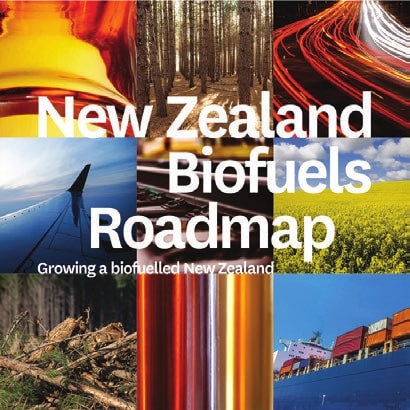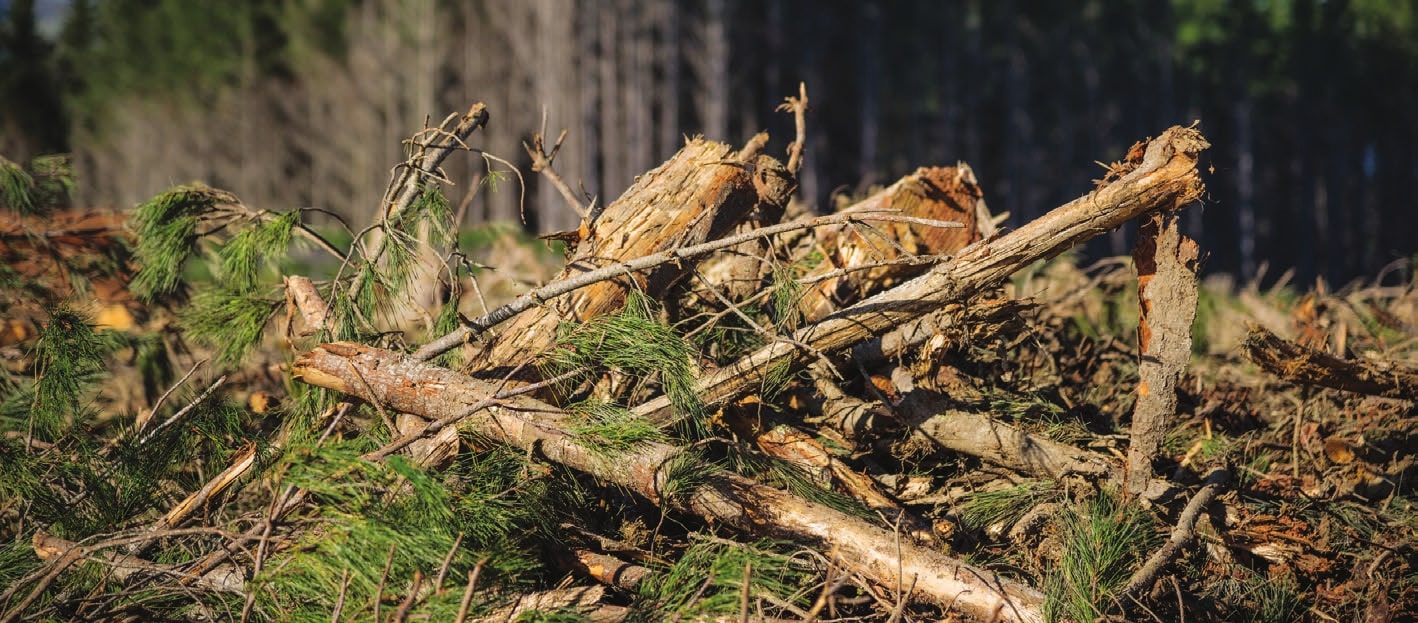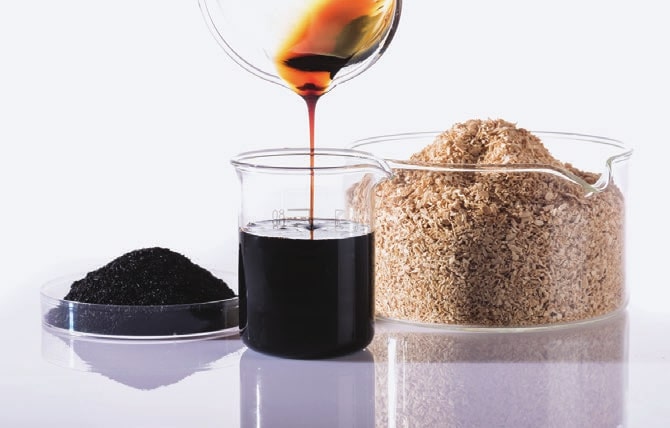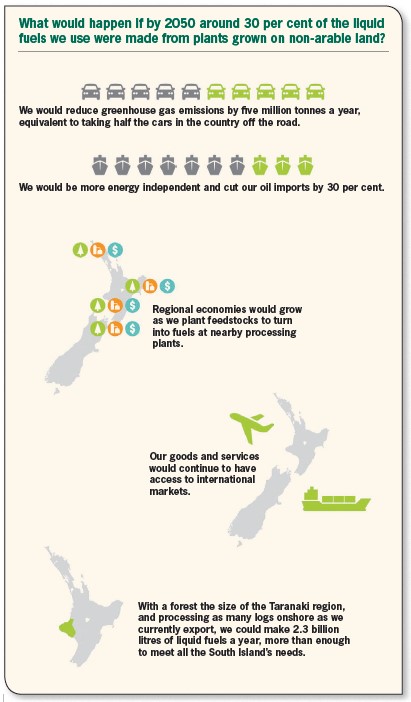Growing a bio-fuelled New Zealand
Michelle Harnett, New Zealand Tree Grower May 2018.
Put a tree into the tank of your tractor, or truck, or even your private jet. Large-scale biofuel production and use in New Zealand is within our grasp, if we have the will. Bioenergy specialists at Scion released their New Zealand Biofuels Roadmap Summary Report − Growing a Biofuelled New Zealand, earlier this year. The study was designed to stimulate debate on large-scale production and use of liquid biofuels. The use of liquid biofuels would significantly reduce New Zealand’s greenhouse gas emissions, particularly for sectors which are difficult to electrify such as aviation, shipping and long-haul road freight, and improve the country’s energy security.
Fuels are mixtures of carbon and hydrogen which originate from plant matter and other elements. Energy-rich fossil fuels have been stored underground for millions of years. Biofuels are made from new plant or animal material converted into forms that can be burned in boilers, engines or even home fireplaces
Common liquid biofuels include ethanol and biodiesel. Ethanol is often made by converting sugar to alcohol just as in beer or winemaking. The source of the sugars can be plants such as sugar cane, corn or whey – a byproduct of cheesemaking. For example, Gull’s Force 10 petrol contains 10 per cent bioethanol from various sources. Biodiesel can be made from oil crops such as canola or used cooking oil and even animal tallow.
Z Energy is planning to produce up to 20 million litres of biodiesel annually using tallow from the meat industry at its new plant in Wiri, Auckland.
A biofuel future for New Zealand?
The Scion study was designed to provide an unbiased view of a wide range of feedstocks and technology options, and to come up with scenarios which explore different possible futures. People can now start seriously considering the role and scale of biofuels in New Zealand.
Five reasons why New Zealand should head towards a bio-fuelled future have been identified. The first is that moving towards liquid fuels from renewable crops will reduce the production of greenhouse gases which contribute to climate change. This feeds into the second reason – greenhouse gas reduction will help the country meet its international commitments under the Paris climate agreement. Closer to home, producing and processing feedstocks into fuels will stimulate regional economies and growth. Locally grown fuels will make the country less dependent on imported oil. Finally, sustainably produced fuels and a reduced greenhouse gas footprint would help maintain access for New Zealand’s goods and services to international markets.



Which fuels?
It will be harder to take fossil carbon out of some transport sectors than from others. Electric or battery powered vehicles are not currently practical in most shipping, aviation, long-haul trucking and machinery working in remote locations. This suggests that diesel, jet fuel and marine oil may be good long-term biofuels target. Petrol will also be needed, even with the rapid uptake of electric vehicles for passenger and light transport, but demand is expected to reduce.
Developing bio-petrol, bio-diesel and other fuels that can be introduced into existing distribution chains and engines, will simplify biofuel uptake. This will be by removing the need for widespread and expensive technology and fuel infrastructure changes.
New value chains
The study looks at possible biofuel value chains. This includes looking at different energy feedstocks, what land classes could be available to grow feedstocks and where the land is located, how to harvest and transport them to a production site, where production should be sited, which conversion technologies to use, and the final fuel mix. The work also took into account that developing a biofuel industry would take time.
The mixing, matching and analysis of the variables was handled by the Bioenergy Value Chain Model. Licensed from the Energy Technologies Institute in the United Kingdom, the model was modified to suit New Zealand conditions. The model balances multiple considerations to find the lowest cost solutions for alternative bio-fuelled futures.
One possible future
One future target might be using biofuels to meet 30 per cent of our liquid fuel needs by 2050. In one 30 per cent substitution option, biofuel replacement could be implemented with very few restrictions. In this example, the model identified the lowest cost solutions without any restrictions on the feedstock, conversion technology and biofuel mix.
The solution using all land classes
The model predicted that the cheapest option would be to produce bio-diesel from canola seed and a mix of petrol and diesel from miscanthus, willow, fbre logs and forest residues. For the first few years until 2025 the main output would be biodiesel from Northland-grown canola processed near Auckland. Then increasing volumes of biomass from existing central North Island forests, along with miscanthus and willow grown in Northland, central North Island and the East Coast would be processed into petrol and various grades of diesel. Finally, new conventional forests, primarily on the East Coast, would mature and become important feedstocks.
The solution using non-arable land
Restricting the available land classes to non-arable land limits feedstock options to forests and forestry wastes. Large volumes of fbre logs from existing and new conventional forests, energy forests and forest residues would be used to produce petrol and diesel. There would also be a lag of 15 to 30 years before new forest resources start to become available from 2030 onwards.
The technology chosen by the model for both land options as having the lowest cost for producing fuels is a combination of pyrolysis, where feedstock are broken down by heat to produce a bio-oil, followed by upgrading the oil to produce fuel. Pyrolysis is a commercially proven technology but upgrading has only been demonstrated on a pilot scale.
Regional growth
The model chooses to grow crops primarily in Northland, the East Coast, the central North Island and Marlborough-Nelson. These are areas where there is available, inexpensive land and the climate is conducive to growth. Processing would take place close to the feedstock sources.
Assuming only non-arable land is used to grow energy feedstocks, new energy forests and conventional forests would need to be planted, increasing the area in planted forests by around 25 per cent.
Translating this to an area such as the East Coast this would mean planting around an extra 80,000 hectares. It would also involve building four pyrolysis plants and four upgrading plants with an input of around $1 billion in capital along with the indirect and direct creation of 1,000 jobs.
Replacing our liquid fuels
More than regional economies would benefit if New Zealand substituted 30 per cent of its liquid fuel consumption with biofuels. Five million tonnes of carbon, or the emissions of half the cars on the road, would be removed from the atmosphere. The country would also become more energy independent as oil imports could be reduced by 30 per cent. A further advantage is that our goods and services would continue to have access to international markets where consumers and legislation are demanding lower carbon footprints.
Which biofuel future could be the best?
We need to have a discussion as a country. Are we serious about reducing greenhouse gas emissions, becoming more energy independent and growing regional economies? Is it acceptable to use arable land or food crops for producing biofuels? Which biofuels should we produce? What level of fuel substitution should we target? When do we want to achieve this by?
Aiming for 30 per cent substitution is just one possibility. The model has been run investigating scenarios with substitution levels between five and 50 per cent, and with pre-determined fuel mixes such as jet fuel. Higher levels of substitution lead to greater reduction in greenhouse gas emissions but costs tend to rise as more costly fuels have to be produced at higher substitution levels. Prescribing a certain fuel mix can also cause costs to increase. Producing jet fuel, for example, currently requires several processing steps, all adding to the cost.
The aim of the Scion study was not to provide definitive answers. Instead the research team wants to show how various liquid biofuel options could work out and get people talking about them. To date, over 70 scenarios have been run. These are a starting point for stakeholders such as forest owners and other potential feedstock growers, technology providers, energy companies, marine and aviation companies, along with regional and national government and the public, to work out what a biofuelled New Zealand might look like.
A biofuelled future is unlikely to happen by itself. We need to agree on the role and scale biofuels should play in replacing fossil fuels. There has to be national commitment to do things properly. The investment needed is large and industries will need a degree of certainty when committing to feedstock and processing options. Government policy support and leadership will be needed to help start production.

Meanwhile what about forestry?
Plantation forestry is most likely to be the best long-term feedstock option for biofuel production. Large scale biofuels will need to be sustainably produced and understood as such by the consumer. This means it would be better to avoid using food crops or land capable of growing food for growing feedstocks. While this does not preclude the use of arable land, it is most likely that steeper and lower cost non-arable land would be used to grow biofuel feedstock – the land currently suitable for planting in trees.
We need to start planting the trees for future fuels now. If New Zealand were to replace 30 per cent of liquid fossil fuels with biofuels by 2050 it is estimated that to fuel the country we would need fbre logs and forestry waste from around 15 per cent of the current planted forest estate, and from another 350,000 hectares of new conventional and energy forests. The best places to plant these trees will be Northland, the East Coast and the central North Island. There may be options to plant and grow other species in energy forests, but exactly what is not clear yet. Owners of small to medium forests should watch this space, join in the discussion and above all, plant more trees.
Biofuel crops
Willow
Fast growing willow or Salix species are being trialled in New Zealand and around the world as a source of biomass for energy production. Willow crops can yield five to 11 tonnes a hectare of dry biomass annually.
It can be grown on land that is not suitable for arable cropping or pasture. A typical growth cycle is three years, followed by mechanical harvesting. The coppiced trees can be harvested six to seven times before they need to be replanted.
Similar to willow, other species can be grown for biomass using short rotation coppicing. These include poplar, robinia and eucalypts grown for two to five years before harvesting.
Energy forests
Energy forests consist of fast-growing trees or woody shrubs specifically grown to provide biomass for energy production. Trees that reach their optimum economic size in eight to 20 years are used in this short rotation forestry. Alder, ash, birch, eucalypts, poplar and sycamore are some of the species grown.
The Scion study used radiata pine grown over a 15-year rotation as a model for an energy forest. Pine could be grown like this using alternative silviculture regimes such as high stocking rates, or trees selected for their growth rate.
Canola
Rapeseed is a member of the brassica family and their oily seeds have a long history of use as fuel. Conventional breeding has developed cultivars such as Brassicus napus and B. rapa, which are safe for humans to consume. The name canola is used to distinguish between the low erucic acid oil and rapeseed oil.
Canola is a good potential source for biodiesel and the seeds contain 40 to 65 per cent oil. Canola oil is most commonly extracted from the seeds either in an oil press or chemically with a solvent. The protein rich meal which remains can be sold as stock food.
In New Zealand, canola has historically been grown for biodiesel production, but most oil is now sold as cooking oil. A hectare of land can produce 3,400 kg of dry seed, or 1,130 kg of oil and 2,240 kg of canola meal. It is usually grown on a three to five-year rotation with other cereal crops, a single canola rotation lasting about six months.
Miscanthus
Miscanthus is a tropical grass related to sugar cane. Miscanthus giganteus has been trialled as a source of biofuel in Europe and North America. In ethanol production, miscanthus often out-performs corn and other alternatives in terms of biomass and volume of ethanol produced. It can also be converted into liquid transport fuels, burned to produce heat and steam for power turbines.
Photosynthesis in miscanthus is very efficient. It has very low nutritional requirements and grows well on less productive land. Rapid growth means it can reach 3.5 metres in a year and yield up to 15 tonnes a hectare of dry biomass annually. It is also sterile and not a food source for humans. Giant miscanthus can be harvested with a silage harvester or mowed and baled.
Miscanthus New Zealand Limited is working towards developing a local miscanthus industry.
Acknowledgements
The work was carried out with multiple stakeholders from the future biofuels value chain, who provided invaluable input during workshops, interviews and webinars. The Ministry of Business, Innovation and Employment financially supported this study via Scion’s Strategic Science Investment Funding.
For more information contact paul.bennett@scionresearch.com


 Farm Forestry New Zealand
Farm Forestry New Zealand